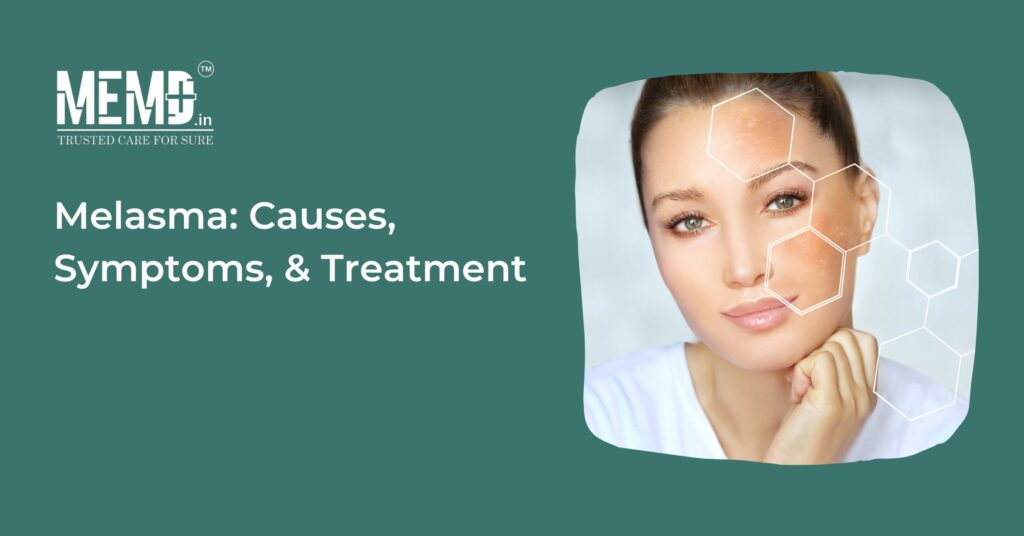
Melasma is a common dermatological problem that causes hyperpigmentation on the skin, especially on the facial skin, cheeks, chin, or nose. These pigmentations are in the form of patches that are usually darker than the rest of the skin. Although it has nothing to do with skin colour, Melasma is often seen to affect dark skin more than fair complexion. It is common in people who are majorly exposed to the sun. Melasma is nothing harmful to your health. However, if someone is not fond of discoloured, uneven skin tone, they may undergo a Melasma treatment. You can go for a Dermatologist Online Consultation if you want to avoid the rush at the clinics. To understand how Melasma can be treated, let’s discuss its symptoms and causes.
What is Melasma?
Melasma, often called Chloasma, is a skin disorder which produces dark patches on the facial skin, makes the skin appear blotchy and results in an uneven skin tone. Women are more common to develop Melasma than men. It can appear anytime in people from 20 to 50 years old. Melasma stimulates the production of melanin, which causes dark patches on your skin. Direct and prolonged exposure to the sun is one of the causes of Melasma.
Causes of Melasma
The actual cause of Melasma is still unclear to doctors. However, some internal and external factors can trigger Melasma. Melasma may result from the malfunctioning melanocytes (responsible for melanin production) in the skin, which results in an overproduction of melanin in certain areas. As melanin production in dark-skinned people is more than in lighter complexions, Melasma commonly occurs more in brown or dark skin than in fair skin.
Some of the common factors that trigger Melasma are-
Internal factors-
Some of the internal factors to trigger Melasma are-
- Genetics- About 50% of people with Melasma get it from their close relatives. Melasma can be a genetic disorder and can be passed on for generations.
- Complexion- Melasma is common in people with brown to dark skin colour, especially if they live in an area with maximum exposure to the sun.
- Pregnancy- Pregnancy is a common trigger for Melasma. When a pregnant woman develops such a skin condition, it is called a ‘mask of pregnancy’.
- Hormones- If you suffer from Thyroid problems, you may develop Melasma. It is not scientifically proven, but many people with Thyroid have complained of developing Melasma.
- Stress- It is one of the rarest triggers of Melasma. But stress can often show symptoms of hyperpigmentation and blotchy skin texture.
External factors
- Sun Exposure- Often and continuous exposure to sun and UV rays can trigger the overproduction of melanin which causes Melasma.
- Inflammation- Regular use of different cosmetic procedures, certain skincare products, or makeup can sometimes cause inflammation on the skin. Certain types of skin inflammation can be a trigger for Melasma.
- Medications- Certain kinds of medication can take a toll on your skin health.
- Hormonal Imbalance- Pregnancy or contraceptive pills can cause hormonal imbalance in the body, which often triggers Melasma.
The reason for a melanocyte malfunction is different for everyone. The factors triggering Melasma have certain cures that only a Skin Specialist Online Consultation will tell you.
Symptoms of Melasma
Hyperpigmentation of the epidermis of the skin, i.e., the topmost player of the skin, is the primary symptom of Melasma. It appears on the lateral parts of the cheeks, nose, and forehead as a dark patch. Some even develop a Melasma on the upper arms. Melasma begins as a few discoloured scars on the skin and may or may not grow as bigger patches.
The initial stage of a Melasma is light brown patches around the face, and then it may gradually grow darker depending on your original skin tone. The areas with maximum sun exposure usually get discoloured, like your forehead and the face’s highest point. In rare cases, Melasma can be seen on the arms, back, and chest.
Treatment of Melasma
Although Melasma is completely harmless for your health, it often causes a lack of confidence as people find the patches not ‘appealing’. You can go for an online skin doctor consultation when you spot discoloured patches on your face. The treatments for Melasma include-
1. Topical Treatment: The doctor may prescribe a combination of medication and medicated creams to be applied topically. This combination helps stop excessive melanin production and promotes cell regeneration.
2. Laser Treatment: These treatments target areas where patches have been developed and remove the hyperpigmentation.
3. Microneedle: Microneedling is techniques where small needles help Melasma creams penetrate deeper into the skin for faster action.
4. Chemical peels are chemicals used to peel off the epidermis skin layer to remove discolouration and encourage new skin growth.
5. Microdermabrasion: It is a type of exfoliation that requires a special tool to improve skin texture and promote new skin.
6. Oral Medication: Some doctors prescribe medications be taken orally. This help reduces inflammation, minimize the appearance of dark patches, and promote cell regeneration.
